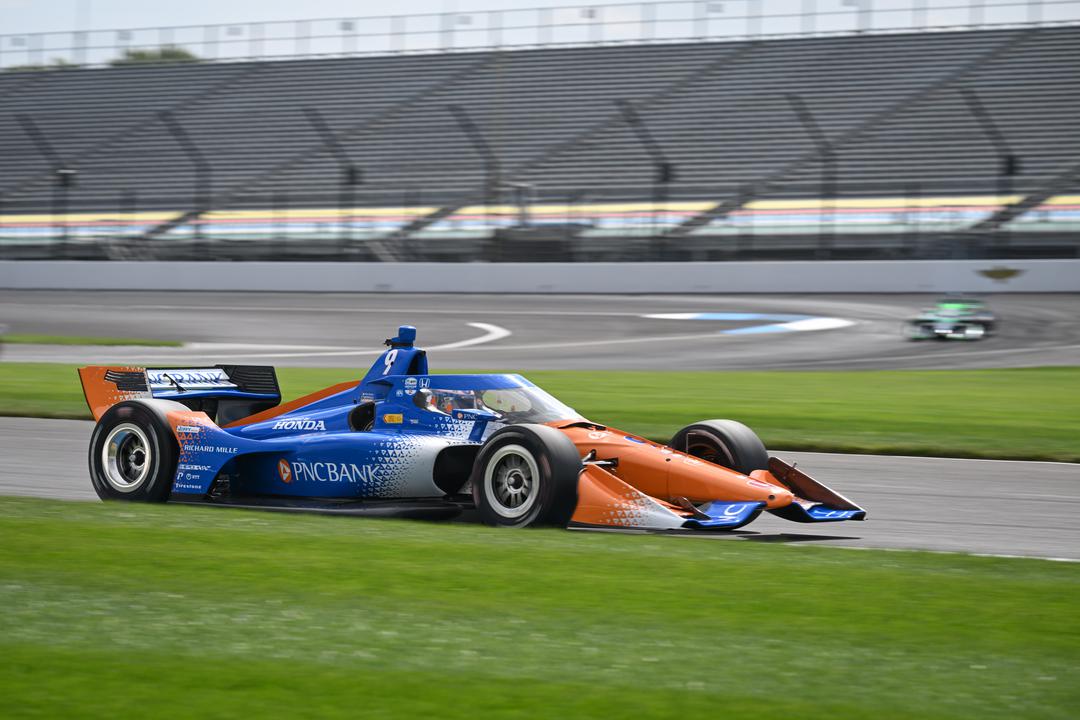

On the first lap of the race, Scott Dixon’s car was spun around inside of Turn 7 after contact with Romain Grosjean.
84 laps later, Dixon crossed the Yard of Bricks to win the Gallagher Grand Prix at the Indianapolis Motor Speedway road course by 0.4779s over Graham Rahal.
“Now I can say I’ve got a spin and win at Indy, which is pretty cool,” Dixon quipped at the post-race press conference.
“I know it’s on the road course and doesn’t count, but I’ll still go with that story.”
While Rahal started on pole, his lead lasted as long as the second turn as Devlin DeFrancesco went around the outside of Pato O’Ward, Christian Lundgaard, and Alexander Rossi to put himself alongside Rahal going to Turn 1.
As DeFrancesco and Rahal went to Turn 2, the Canadian was on the inside and took the lead in the #29 Andretti Steinbrenner Autosport Honda.
Meanwhile as the field went to Turn 7, Alex Palou attempted to overtake team-mate Marcus Armstrong, Rossi and Felix Rosenqvist at once before attempting to back out of the move before the corner.
The championship leader lightly hit Armstrong’s car, causing the #11 Chip Ganassi Racing Honda to spin.
In the jamming effect, Grosjean lightly hit Dixon, turning the #9 Chip Ganassi Racing Honda around on the left side of the circuit.
Grosjean came to a stop behind Armstrong’s sideways car but Josef Newgarden hit the right front of Armstrong’s car, knocking the nose assembly off the #2 Team Penske Chevrolet.
Newgarden didn’t get restarted fast enough to avoid going a lap down to the leaders.
DeFrancesco led the field back to the green flag at the end of Lap 7 but did not hold onto the lead for long as Rahal grabbed the top spot at the start of Lap 9.
Rahal kept the lead until his first pit stop on Lap 24, handing the lead to Lundgaard who pitted two laps later, giving the lead to Dixon who pitted on Lap 32.
Dixon’s strategy was now becoming clear. While the race was still under full course yellow conditions, the CGR crew called the 2008 Indianapolis 500 winner to pit road on Lap 5 to get off the black sidewall primary compound tires and fill up his car’s fuel tank.
With Dixon now able to run the rest of the race on the preferred red sidewall alternate compound tyres that give more grip, Dixon’s strategy now became a pure fuel conservation run.
With a few laps in hand over the rest of the field, Dixon could run the rest of the race with one fewer pit stop under green flag conditions if he saved enough fuel.
Dixon pitted for the final time on Lap 59, handing the lead to Rahal who pitted five laps later, exiting the pits behind Dixon.
Dixon’s lead was just over seven seconds with just over 20 laps to go. The fight for the win was on.
As Rahal steadily gained a few tenths of a second per lap on Dixon, slower cars started to play a part as the race drew to a close.
After spending more than a lap behind Ryan Hunter-Reay, the 34-year-old gave the Floridian a gesture of frustration after passing the 2014 Indianapolis 500 winner with five laps to go.
“I wasn’t very pleased,” Rahal said.
“Ryan is a very close friend so I’m not going to say much. I didn’t think it needed to be a lap and a half or two laps for him to let me by. Pato will tell you the same thing.
“When you’re a second back of a car, it becomes a struggle, period. It’s not easy. The lapped cars, they know that.
“They could make the job, particularly in the closing stages like that, slightly easier.
“Having said that, on the flipside, I thought Marcus Armstrong was amazing to let me right through.
“I was chasing his team-mate. He certainly didn’t need to make my life that easy. He did a wonderful job.
“I saw both sides of it today. Dixie had the same.”
After overtaking Hunter-Reay, Rahal closed to about a quarter of a second behind Dixon’s car with two laps to go.
Dixon fought to maintain his streak of seasons with a win intact. Rahal fought to end a winless drought that stretched back to June of 2017 at Detroit.
In the end, Dixon prevailed over Rahal to extend his winning streak to 19 seasons in a row. The win was Dixon’s 54th IndyCar victory and it happened on his 319th consecutive IndyCar start, breaking a record set by 2013 Indianapolis 500 winner Tony Kanaan.
The win was another example of Dixon making the most of a bad opening lap.
After being caught up in a multi-car incident on the first lap at Portland International Raceway in 2018, Dixon’s car was functional enough to make it back to pit road and he finished fifth after repairs.
This time around, the method to get to victory lane was a bit more complicated, but it didn’t cause the team to deviate from their strategy.
“We were going to pit,” Dixon said of his strategy.
“We were going to kind of try the two-stop early anyway. The difference being we were on the black tyre, we kind of wanted to get rid of the black tyre pretty quickly.
“Hoping to have great faith that the red was actually going to last, and it did.
“I knew we weren’t out of it at that point because if anybody tried to do the two-stop [strategy], you could still win the race from that period.
“Honestly, the Caution was a little longer about a lap or two maybe than we thought. That helped us where we didn’t have to get crazy fuel mileage.”
O’Ward finished third ahead of Lundgaard in fourth and Rossi in fifth. Will Power finished sixth, Scott McLaughlin finished eighth and Armstrong finished 24th after his involvement in the first lap incident.
IndyCar points leader Palou finished seventh and increased his lead to 101 points.
By winning, Dixon leapfrogged Newgarden and is now second in points, four ahead of the 2023 Indianapolis 500 winner.





















Discussion about this post